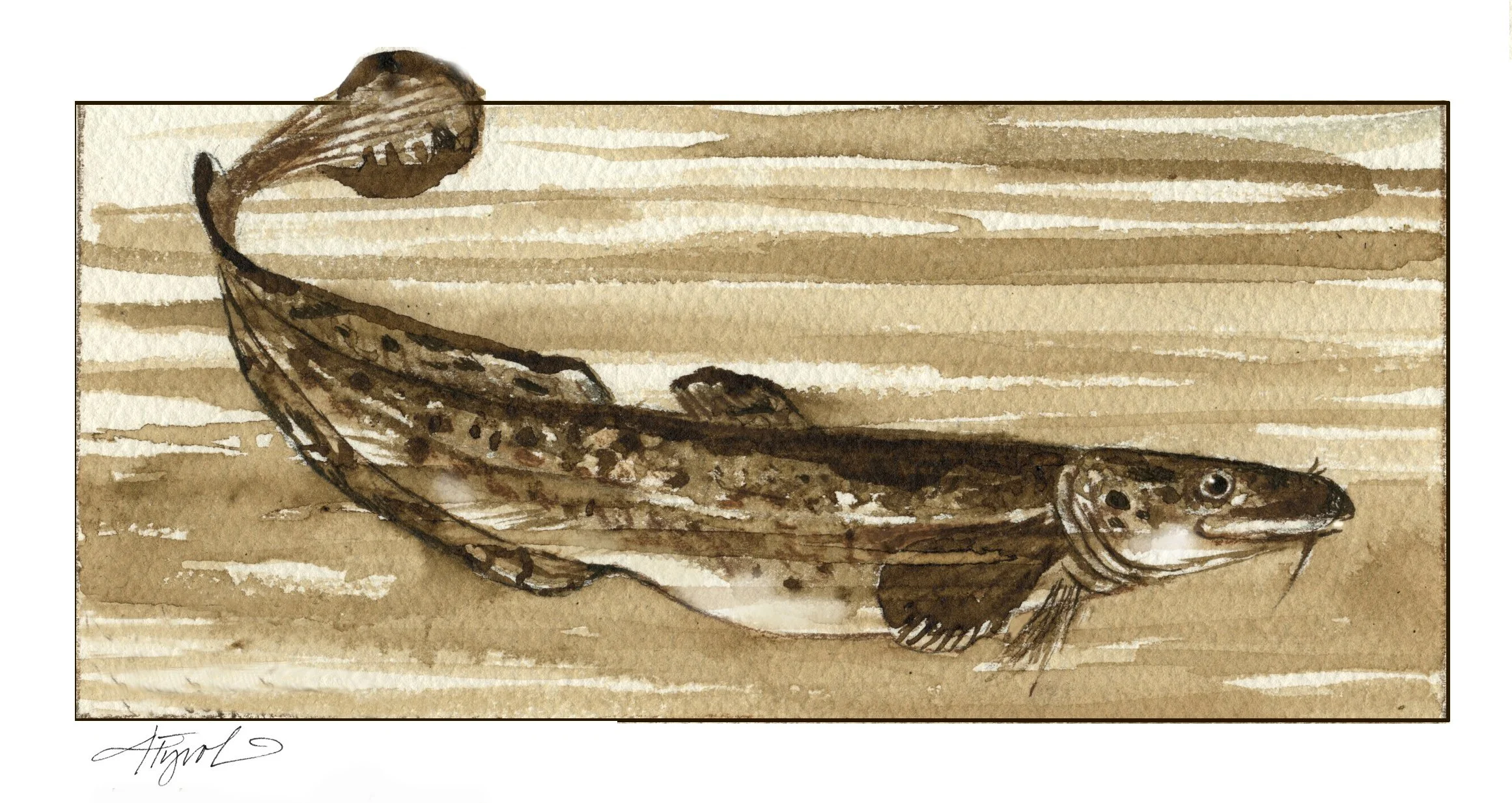The Outside Story: Meet New England’s musical fish, the burbot
Feb. 24, 2023 | By Doug FaceyIllustration by Adelaide Murphy Tyrol
In the midst of winter, the ice-covered lakes of New England seem quiet. It may, however, be a bit noisy below the ice. Winter into early spring is the spawning season for burbot, when males produce sounds to attract mates.
Burbot (Lota lota), also called cusk, lingcod, eelpout, and a few other names, are the only freshwater members of the group of fish that includes cods. The body of a burbot is long and has two dorsal fins – the first being rather short and the second much longer; there is also a long anal fin along the underside. The scales are very small and embedded in the skin, making these fish very slippery. The head is somewhat flattened and broad, with a single fleshy barbel under the chin, a characteristic they share with other cods. Barbels contain taste buds that help fish identify potential food. Burbot also have two protruding tubular nostrils, similar to eels.
The combination of an elongated, slippery body, eel-like tubular nostrils, and a head somewhat similar to that of a bullhead (a member of the catfish family also called bullpout), may be what earned burbot the name “eelpout,” although they are not closely related to either eels or catfish.
Burbot inhabit cold rivers and streams and deep, cold-water lakes across North America, Europe, and parts of Asia. Adult burbot are often between 12 and 24 inches long, but can exceed 30 inches. Females are generally larger than males. State records for burbot are 10.9 pounds in Vermont, 12.8 pounds in New Hampshire, and 18.5 pounds in Maine; in northern Canada and Alaska, burbot can exceed 20 pounds. Anglers value the species, as burbot yield firm, light meat similar to that of their cod cousins.
Those burbot that live in lakes spend much of the year in the deep areas where the water is coldest, often passing the day in burrows in the substrate and coming out to feed at dawn and dusk. Burbot feed primarily on other fish, but will also eat aquatic invertebrates such as insects, clams, and crayfish. Burbot grow slowly, typically reaching maturity between 4 and 7 years old, and can live to be 20 years old.
In winter, burbot move into shallower areas, typically under ice, and spawn over silt-free substrates such as sand and gravel when water temperatures are 34 to 40 degrees. Like their cod relatives, burbot use sound to attract mates during spawning. Males create sounds – ranging from slow clicks and knocks to faster buzzes – by rapidly contracting and vibrating muscles against the wall of their gas bladder, an internal gas-filled organ used to regulate buoyancy, which acts like a drum during sound production. The drumming muscles grow larger as the spawning period approaches.
To test the idea that male burbot use sound to attract females, researchers in northwestern Canada placed adult burbot in an enclosure within a lake, and recorded sounds using underwater microphones. Sound production was greatest between late January and mid-March, and was especially intense during two days in early February that coincided with the onset of burbot spawning in the bay in which the study was located.
Spawning in burbot is highly synchronized, with fish congregating in large numbers. During spawning, females are often surrounded by multiple males, sometimes in large groups. Females release eggs while males simultaneously release sperm to fertilize the eggs. Burbot typically spawn several times during a two-to-three week period, and a female may release from 60,000 to more than 3 million eggs in a single spawning season; the largest females produce the most eggs.
Burbot do not construct nests – the fertilized eggs sink and develop among the sand and gravel substrate, taking from 30 to more than 120 days to hatch, depending on water temperature. Adult burbot do not protect the fertilized eggs or developing young, but they produce many eggs, thus increasing the likelihood that some will survive.
Doug Facey is an emeritus professor of biology at Saint Michael’s College and lives in Burlington. The Outside Story is assigned and edited by Northern Woodlands magazine and sponsored by the Wellborn Ecology Fund of the New Hampshire Charitable Foundation.

